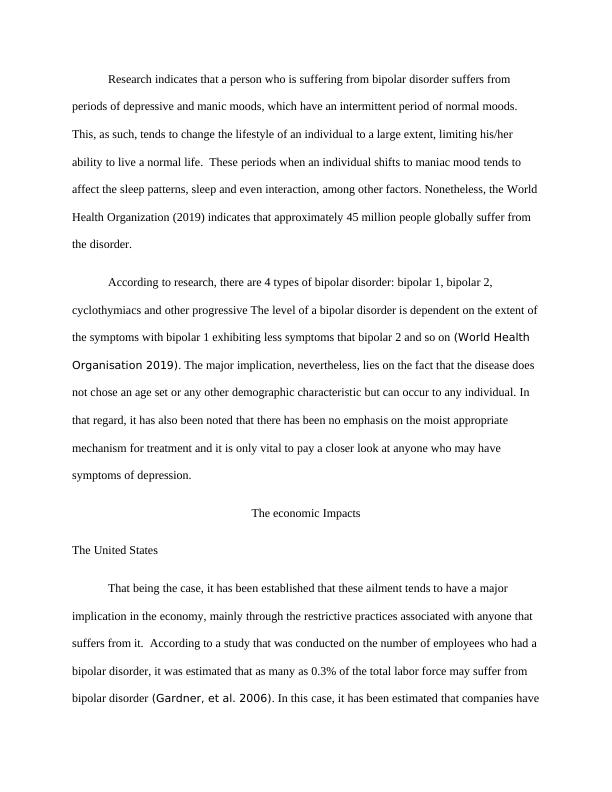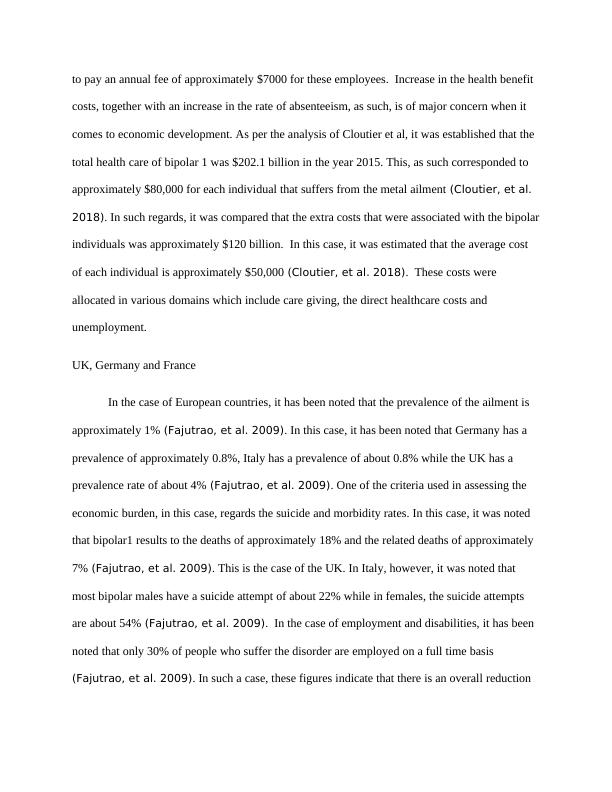National Health Service Bipolar Disorder
Added on 2022-09-13
7 Pages1510 Words19 Views
National Health Service Bipolar Disorder
Name of student:
Institutional Affiliations:
Problem Justification
Name of student:
Institutional Affiliations:
Problem Justification

Research indicates that a person who is suffering from bipolar disorder suffers from
periods of depressive and manic moods, which have an intermittent period of normal moods.
This, as such, tends to change the lifestyle of an individual to a large extent, limiting his/her
ability to live a normal life. These periods when an individual shifts to maniac mood tends to
affect the sleep patterns, sleep and even interaction, among other factors. Nonetheless, the World
Health Organization (2019) indicates that approximately 45 million people globally suffer from
the disorder.
According to research, there are 4 types of bipolar disorder: bipolar 1, bipolar 2,
cyclothymiacs and other progressive The level of a bipolar disorder is dependent on the extent of
the symptoms with bipolar 1 exhibiting less symptoms that bipolar 2 and so on (World Health
Organisation 2019). The major implication, nevertheless, lies on the fact that the disease does
not chose an age set or any other demographic characteristic but can occur to any individual. In
that regard, it has also been noted that there has been no emphasis on the moist appropriate
mechanism for treatment and it is only vital to pay a closer look at anyone who may have
symptoms of depression.
The economic Impacts
The United States
That being the case, it has been established that these ailment tends to have a major
implication in the economy, mainly through the restrictive practices associated with anyone that
suffers from it. According to a study that was conducted on the number of employees who had a
bipolar disorder, it was estimated that as many as 0.3% of the total labor force may suffer from
bipolar disorder (Gardner, et al. 2006). In this case, it has been estimated that companies have
periods of depressive and manic moods, which have an intermittent period of normal moods.
This, as such, tends to change the lifestyle of an individual to a large extent, limiting his/her
ability to live a normal life. These periods when an individual shifts to maniac mood tends to
affect the sleep patterns, sleep and even interaction, among other factors. Nonetheless, the World
Health Organization (2019) indicates that approximately 45 million people globally suffer from
the disorder.
According to research, there are 4 types of bipolar disorder: bipolar 1, bipolar 2,
cyclothymiacs and other progressive The level of a bipolar disorder is dependent on the extent of
the symptoms with bipolar 1 exhibiting less symptoms that bipolar 2 and so on (World Health
Organisation 2019). The major implication, nevertheless, lies on the fact that the disease does
not chose an age set or any other demographic characteristic but can occur to any individual. In
that regard, it has also been noted that there has been no emphasis on the moist appropriate
mechanism for treatment and it is only vital to pay a closer look at anyone who may have
symptoms of depression.
The economic Impacts
The United States
That being the case, it has been established that these ailment tends to have a major
implication in the economy, mainly through the restrictive practices associated with anyone that
suffers from it. According to a study that was conducted on the number of employees who had a
bipolar disorder, it was estimated that as many as 0.3% of the total labor force may suffer from
bipolar disorder (Gardner, et al. 2006). In this case, it has been estimated that companies have

to pay an annual fee of approximately $7000 for these employees. Increase in the health benefit
costs, together with an increase in the rate of absenteeism, as such, is of major concern when it
comes to economic development. As per the analysis of Cloutier et al, it was established that the
total health care of bipolar 1 was $202.1 billion in the year 2015. This, as such corresponded to
approximately $80,000 for each individual that suffers from the metal ailment (Cloutier, et al.
2018). In such regards, it was compared that the extra costs that were associated with the bipolar
individuals was approximately $120 billion. In this case, it was estimated that the average cost
of each individual is approximately $50,000 (Cloutier, et al. 2018). These costs were
allocated in various domains which include care giving, the direct healthcare costs and
unemployment.
UK, Germany and France
In the case of European countries, it has been noted that the prevalence of the ailment is
approximately 1% (Fajutrao, et al. 2009). In this case, it has been noted that Germany has a
prevalence of approximately 0.8%, Italy has a prevalence of about 0.8% while the UK has a
prevalence rate of about 4% (Fajutrao, et al. 2009). One of the criteria used in assessing the
economic burden, in this case, regards the suicide and morbidity rates. In this case, it was noted
that bipolar1 results to the deaths of approximately 18% and the related deaths of approximately
7% (Fajutrao, et al. 2009). This is the case of the UK. In Italy, however, it was noted that
most bipolar males have a suicide attempt of about 22% while in females, the suicide attempts
are about 54% (Fajutrao, et al. 2009). In the case of employment and disabilities, it has been
noted that only 30% of people who suffer the disorder are employed on a full time basis
(Fajutrao, et al. 2009). In such a case, these figures indicate that there is an overall reduction
costs, together with an increase in the rate of absenteeism, as such, is of major concern when it
comes to economic development. As per the analysis of Cloutier et al, it was established that the
total health care of bipolar 1 was $202.1 billion in the year 2015. This, as such corresponded to
approximately $80,000 for each individual that suffers from the metal ailment (Cloutier, et al.
2018). In such regards, it was compared that the extra costs that were associated with the bipolar
individuals was approximately $120 billion. In this case, it was estimated that the average cost
of each individual is approximately $50,000 (Cloutier, et al. 2018). These costs were
allocated in various domains which include care giving, the direct healthcare costs and
unemployment.
UK, Germany and France
In the case of European countries, it has been noted that the prevalence of the ailment is
approximately 1% (Fajutrao, et al. 2009). In this case, it has been noted that Germany has a
prevalence of approximately 0.8%, Italy has a prevalence of about 0.8% while the UK has a
prevalence rate of about 4% (Fajutrao, et al. 2009). One of the criteria used in assessing the
economic burden, in this case, regards the suicide and morbidity rates. In this case, it was noted
that bipolar1 results to the deaths of approximately 18% and the related deaths of approximately
7% (Fajutrao, et al. 2009). This is the case of the UK. In Italy, however, it was noted that
most bipolar males have a suicide attempt of about 22% while in females, the suicide attempts
are about 54% (Fajutrao, et al. 2009). In the case of employment and disabilities, it has been
noted that only 30% of people who suffer the disorder are employed on a full time basis
(Fajutrao, et al. 2009). In such a case, these figures indicate that there is an overall reduction

End of preview
Want to access all the pages? Upload your documents or become a member.
Related Documents
Implementing Psychoeducation for Bipolar Disorder Management in Psychiatric Wardlg...
|37
|10904
|259
Mental Health - Bipolar Disorderlg...
|17
|4429
|63
Psychological Disorders and Treatmentlg...
|8
|1420
|193
Bipolar Disorder: A Guide for Patients and Family Memberslg...
|25
|1936
|94
(PDF) Bipolar Affective Disorderlg...
|8
|2099
|43
Few Symptoms of Bipolar Disorderlg...
|11
|2967
|21
